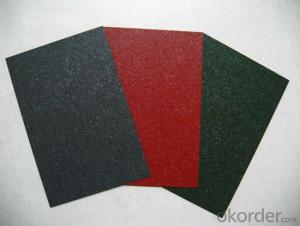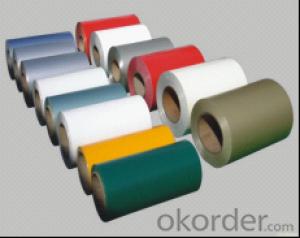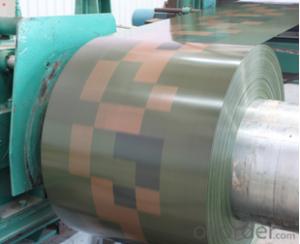Hot dipped color coated Galvanized steel from China, CNBM, fast delivery
- Loading Port:
- China main port
- Payment Terms:
- TT OR LC
- Min Order Qty:
- 1 m.t.
- Supply Capability:
- 100000 m.t./month
OKorder Service Pledge
OKorder Financial Service
You Might Also Like
1) AVAILABLE DESIGNATION OF (Prepainted galvanized steel coils) printed PPGI coils
Quality Q/BQB 440-2003 JIS G3312-1994 EN 10326-2004 ASTM A653-02a
EN 10327-2004 (BASE PLATE)
(BASE PLATE)
Commercial Steel TDC51D CGCC DX51D+Z/AZ CS Type A/B/C
Forming Steel (TSt01,TSt02,TSt03) CGCD1 FS Type A, Type B
Drawing TDC52D /TDC53D - DX52D+Z/AZ DDS TYPE A/C
Steel DX53D+Z/AZ
Structural TS280GD(TStE28) CGC400 S280D+Z/AZ SS275
Steel TS350GD(TStE34) CGC440 S350D+Z/AZ SS340 Class1
2) OUR SPECIFICATION OF (Prepainted galvanized steel coils) printed PPGI coils
Available Size:
Manufacturer Thickness Width Length of plate Inner diameter of coil
JIANGSU HUIYE STEEL SHEET CO.,LTD 0.2-1.2mm 800/914/1000/1200/1219/1250mm 1000-6000mm 508mm/610mm
Coated Mass OF (Prepainted galvanized steel coils) printed PPGI coils:
Base plate Available Coated Mass(g/m^2)
Galvanized Steel 80, 100, 120, 160, 180
Galvalume Steel 50, 70, 150
Available Painting OF (Prepainted galvanized steel coils) printed PPGI coils:
Category of Painting Item Code
Polyester PE
High-durability polyester HDP
Silicon modified polyesters SMP
Polyvinylidene fluoride PVDF
Easy-Cleaning —
Painting Thickness Top side: 20+5microns;
Bottom side: 5~7microns.
Color System Produce according to RAL Color System or as per buyer’s color sample.
Painting structure Top surface Bottom surface
Primer coating No coating 1/0
Primer coating Primer coating 1/1
Primer coating + Finish coating No coating 2/0
Primer coating + Finish coating Primer coating or single back coating 2/1
Primer coating + Finish coating Primer coating + Finish back coating 2/2
- Q:Can steel sheets be used for elevator interiors?
- Yes, steel sheets can be used for elevator interiors. Steel is a durable and versatile material that can be easily customized and shaped to fit the interior design requirements of an elevator. It provides a sleek and modern look, while also offering strength and durability to withstand daily wear and tear.
- Q:What is the difference between hot-rolled and cold-rolled steel sheets?
- The manufacturing process and resulting characteristics of steel sheets differ between hot-rolled and cold-rolled varieties. Hot-rolled steel sheets are produced by heating a large steel slab and passing it through high-temperature rollers. This allows for easy shaping and forming into various sizes and thicknesses. The elevated temperature also removes any residual stress in the steel, making it more flexible and moldable. Consequently, hot-rolled steel sheets possess a rougher surface finish and may exhibit a thin oxide layer called scale. However, they are generally less expensive and come in a wider range of sizes. In contrast, cold-rolled steel sheets are created by cooling down the hot-rolled steel and passing it through rollers at room temperature. This process not only reduces the steel's thickness but also enhances its surface finish and dimensional accuracy. Cold-rolling gives the steel sheets a smooth and shiny appearance, making them suitable for applications where aesthetics matter. Additionally, cold-rolling improves the steel's strength and hardness, making it more appropriate for high-stress uses. However, cold-rolled steel sheets are typically more costly due to the additional processing involved. In summary, hot-rolled steel sheets offer greater formability and lower cost, but have a rougher surface finish and may exhibit scale. On the other hand, cold-rolled steel sheets have superior surface finish, dimensional accuracy, and strength, but are pricier. Choosing between hot-rolled and cold-rolled steel sheets depends on the specific requirements of the application, including desired surface finish, strength, and cost considerations.
- Q:How do steel sheets perform in terms of corrosion resistance?
- Steel sheets possess good corrosion resistance in general, particularly when they are coated with protective layers like zinc or alloys. The corrosion resistance of steel sheets relies on the steel's composition and quality, as well as the environment in which they are employed. Stainless steel sheets, for instance, demonstrate remarkable resistance against corrosion due to the presence of chromium and other alloying elements. These sheets prove highly effective in environments with elevated humidity, exposure to saltwater, or acidic conditions. However, in aggressive environments, uncoated or low-alloy steel sheets may be vulnerable to rust and corrosion. Regular maintenance, such as the application of protective coatings or the use of corrosion inhibitors, can enhance the corrosion resistance of steel sheets and extend their lifespan.
- Q:How do steel sheets perform in terms of air permeability?
- Steel sheets have a very low air permeability, meaning that they do not allow air to pass through easily.
- Q:What are the tolerances for steel sheets?
- The tolerances for steel sheets typically depend on the specific industry and application. However, common tolerances for steel sheets are usually specified in terms of thickness, flatness, width, and length. These tolerances can vary but are typically within a few percentage points of the specified dimensions.
- Q:Can steel sheets be used for electrical grounding purposes?
- Certainly! Electrical grounding purposes can indeed utilize steel sheets. Steel, being an excellent conductor of electricity, is well-suited for grounding applications. By appropriately linking them to an electrical system, steel sheets can offer an efficient route for the discharge of electrical charges and the avoidance of electrical shock risks. Nevertheless, it is crucial to guarantee that the steel sheets are suitably bonded and connected to the grounding system to establish a path of low resistance for fault currents. Furthermore, factors like the thickness and surface area of the steel sheets should be taken into account to ensure they satisfy the criteria for effective grounding.
- Q:How do steel sheets perform in marine environments?
- Steel sheets perform well in marine environments due to their high strength and corrosion resistance properties. The presence of saltwater and high levels of moisture in marine environments can cause significant damage to many materials, but steel sheets are specifically designed to withstand these conditions. One of the key factors that contribute to the performance of steel sheets in marine environments is their corrosion resistance. Steel sheets are typically coated with zinc or other protective coatings, such as epoxy or galvanized coatings, which act as a barrier against corrosion. These coatings prevent the steel from coming into direct contact with saltwater and moisture, reducing the risk of rust and deterioration. Additionally, the high strength of steel sheets makes them highly durable in marine environments. They can withstand the harsh conditions, including waves, strong winds, and impact from debris. This strength ensures that steel sheets can maintain their structural integrity and offer long-term performance. Furthermore, steel sheets are also known for their fire resistance, which is crucial in marine environments where safety is of utmost importance. Steel has a high melting point and does not contribute to the spread of fire, making it a reliable choice for marine applications. However, it is important to note that even with their excellent performance, steel sheets may still require regular maintenance and inspection in marine environments. This includes monitoring for signs of corrosion, repairing or replacing damaged coatings, and addressing any potential issues promptly to ensure their continued performance. In conclusion, steel sheets are a reliable choice for marine environments due to their corrosion resistance, high strength, and fire resistance. They can withstand the challenging conditions of saltwater, moisture, and impact, making them an ideal material for various marine applications.
- Q:Are steel sheets suitable for harsh weather conditions?
- Steel sheets are highly suitable for harsh weather conditions due to their durability and strength. Steel is renowned for its ability to withstand extreme weather conditions, including high winds, heavy rain, snow, and hail. Moreover, steel sheets are designed to resist corrosion, rust, and degradation caused by prolonged exposure to severe weather, ensuring their longevity and dependability in any climate. Furthermore, steel sheets can be coated with protective finishes, such as galvanized or painted coatings, which further enhance their resistance to weathering. This aspect has made steel sheets a popular choice for various applications in areas prone to harsh weather, such as roofing, siding, and outdoor structures. They provide exceptional protection and structural integrity even in the most challenging weather conditions.
- Q:Are steel sheets suitable for laser cutting or engraving?
- Yes, steel sheets are suitable for laser cutting and engraving due to their high melting point and durability. Laser technology can precisely cut and engrave intricate designs on steel sheets, making them a popular material choice in various industries.
- Q:What kind of steel plate is HIC?
- Hydrogen sulfide corrosion resistant steel plate is generally used in some specific occasions, LONCIN steel grid plate for you to answer
1. Manufacturer Overview |
|
|---|---|
| Location | |
| Year Established | |
| Annual Output Value | |
| Main Markets | |
| Company Certifications | |
2. Manufacturer Certificates |
|
|---|---|
| a) Certification Name | |
| Range | |
| Reference | |
| Validity Period | |
3. Manufacturer Capability |
|
|---|---|
| a)Trade Capacity | |
| Nearest Port | |
| Export Percentage | |
| No.of Employees in Trade Department | |
| Language Spoken: | |
| b)Factory Information | |
| Factory Size: | |
| No. of Production Lines | |
| Contract Manufacturing | |
| Product Price Range | |
Send your message to us
Hot dipped color coated Galvanized steel from China, CNBM, fast delivery
- Loading Port:
- China main port
- Payment Terms:
- TT OR LC
- Min Order Qty:
- 1 m.t.
- Supply Capability:
- 100000 m.t./month
OKorder Service Pledge
OKorder Financial Service
Similar products
New products
Hot products
Related keywords































